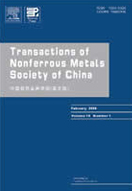Anomalous yield and intermediate temperature brittleness behaviors of directionally solidified nickel-based superalloy
(1. Shenzhen Institute, Peking University, Shenzhen 518057, China;
2. Shenzhen Airlines, Shenzhen Bao’an International Airport, Shenzhen 518128, China;
3. Institute of Metal Research, Chinese Academy of Sciences, Shenyang 110016, China)
2. Shenzhen Airlines, Shenzhen Bao’an International Airport, Shenzhen 518128, China;
3. Institute of Metal Research, Chinese Academy of Sciences, Shenyang 110016, China)
Abstract: A nickel-based superalloy with good corrosion resistance was fabricated by directional solidification, and its microstructure and tensile properties at elevated temperatures were investigated. Microstructure observations reveal that the γ′ precipitates are arrayed in the γ matrix regularly with some MC, Ni5Hf and M3B2 particles distributed along the grain boundary. The tensile tests exhibit that the tensile properties depend on temperature significantly and demonstrate obvious anomalous yield and intermediate-temperature brittleness (ITB) behavior. Below 650 °C, the yield strength decreases slightly but the ultimate tensile strength almost has no change. When the temperature is between 650 °C and 750 °C, the yield and ultimate tensile strengths rise rapidly, and after then they both decrease gradually with temperature increasing further. The elongation has its minimum value at about 700 °C. The TEM examination exhibits that sharing of the γ′ by dislocation is almost the main deformation mechanism at low temperatures, but the γ′ by-pass dominates the deformation at high temperatures. The transition temperature from shearing to by-pass should be around 800 °C. The anomalous yield and intermediate-temperature brittleness behaviors should be attributed to the high content of γ′. In addition, the carbides and eutectic structure also contribute some to the ITB behaviors of the alloy.
Key words: nickel-based superalloy; directional solidification; anomalous yield; intermediate-temperature brittleness; microstructure

